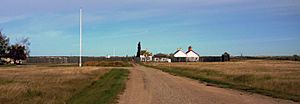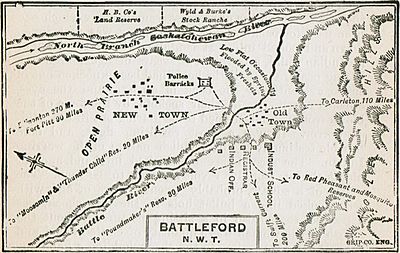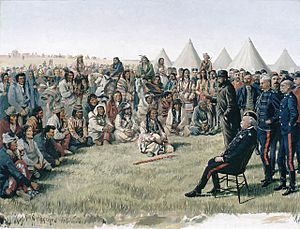Looting of Battleford facts for kids
Quick facts for kids Looting of Battleford |
|||||
|---|---|---|---|---|---|
| Part of the North-West Rebellion | |||||
 Fort Battleford National Historic Site |
|||||
|
|||||
The Looting of Battleford happened in March 1885. It was part of the North-West Rebellion in the town of Battleford, Saskatchewan. At that time, Battleford was in the Northwest Territories.
Just a few days after the Métis people won the Battle of Duck Lake on March 26, 1885, things changed. Some Cree groups who supported the Métis began to act. They also had their own problems with the government. These groups started raiding stores and farms in western Saskatchewan. They were looking for weapons, bullets, and food. Many people living in the area fled to bigger towns and forts for safety.
Two important leaders of this uprising were Chief Poundmaker and Chief Big Bear. Poundmaker and his group lived on a reserve near Cut Knife, about 50 kilometers (31 miles) west of Fort Battleford. Big Bear and his group were near Frog Lake, about 55 kilometers (34 miles) northwest of Fort Pitt. They had not yet chosen a reserve site. Both groups had signed Treaty 6 with the Canadian government. However, they were unhappy with how the treaty was being carried out. The disappearance of the buffalo and the small amounts of food given by government agents meant the groups were often very hungry.
Battleford's Location in 1885
In 1885, the District of Saskatchewan had about 10,595 people. The western part of the district was where the Cree uprising happened. This area included Battleford.
Battleford was one of the largest settlements. It had about 500 people, including French, Métis, and English settlers. The town is located by the Battle River, close to the North Saskatchewan River. The "Old Town" was on the south side of the Battle River. The "New Town" and Fort Battleford were on the north side, closer to the North Saskatchewan River.
Later, in 1905, the city of North Battleford was founded. This happened when the Canadian Northern Railway built its main line on the north side of the North Saskatchewan River.
The Siege of Battleford
On March 28, news spread that several Indigenous groups, including Poundmaker's, were heading to Battleford. Settlers quickly started moving into Fort Battleford. This fort was a North-West Mounted Police post, led by Colonel Morris and 25 police officers. Over the next few days, about 500 civilians found safety inside the fort's walls. Many crossed the Battle River on a shaky ice bridge, leaving most of their belongings behind in the Old Town. On the night of March 29, nearby farms were raided. Horses and cattle were taken by the groups.
Also on their way to join Poundmaker were the Assiniboine from the Eagle Hills. They were about 30 kilometers (19 miles) south of Battleford. On March 29, they killed their farm instructor, John Payne. They also raided farms along the way, killing a farmer named Fremont.
On March 30, Poundmaker asked to meet with the government agent, J. M. Rae. When Rae refused, the groups in Battleford took food and supplies from the empty stores and houses. The next day, the groups camped a few miles away. They brought their stolen food, cattle, and horses with them. Eventually, they returned to Poundmaker's reserve.
The New Town was safe because it was close to the Fort and its cannon. But the Old Town was not protected. Every day, until Colonel Otter's soldiers arrived on April 24, the people in the Fort watched. They saw the Old Town, about a mile away, being robbed. Stolen wagons and horses carried away supplies from the Hudson's Bay Company and other shops. All the public buildings were attacked, including the Battleford Industrial School. Most homes were burned down, even the large house of Judge Charles Rouleau. Only about six houses were left standing.
What Happened Next
On May 2, Colonel Otter's soldiers attacked Poundmaker's camp at Cut Knife Creek. But they were forced to go back to Battleford. Poundmaker stopped his warriors from attacking the retreating soldiers.
On May 14, near Eagle Hills, a Battleford group captured a wagon train. This train was carrying supplies for Colonel Otter's soldiers.
After the Métis were defeated at the Battle of Batoche, Louis Riel surrendered on May 15. Then, Pitikwahanapiwiyin (Poundmaker) surrendered to General Middleton at Fort Battleford on May 26.



